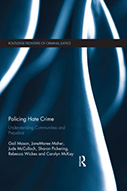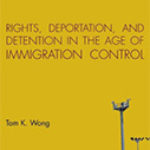Policing Hate Crime: Understanding Communities and Prejudice

Authors: Gail Mason, JaneMaree Maher, Jude McCulloch, Sharon Pickering, Rebecca Wickes and Carolyn McKay
Publisher: London; New York: Routledge, 2017. 203p.
Reviewer: Susann Wiedlitzka | May 2018
As a part of Routledge’s Frontiers of Criminal Justice series, Policing Hate Crime: Understanding Communities and Prejudice explores how a common understanding of hate crime may foster police-community cooperation and trust. The book addresses this important factor that has not been previously addressed in the hate crime literature through a research partnership between academics and the police. The authors explore the complexities of effective policing practices in the context of hate crime terminology and the potential for misunderstandings of hate crime and how to overcome these. The book highlights one of the key reasons for diverse communities to refrain from reporting hate crime to police: a lack of trust.
Policing Hate Crime: Understanding Communities and Prejudice comprises four parts. Part I includes a thorough introduction to the topic and the main aims of the book. The introduction sets this Australian-focused research into the international context by comparing definitions, victimization, policing as well as challenges for police, introduces the Victoria Police as the research case study, and provides a detailed overview of the book.
Part II of the book details the context for policing hate crime in Victoria. In chapter 2, the authors not only critically discuss different hate crime terminology (i.e., hate crime, bias crime, targeted violence and prejudice motivated crime) used in varying Australian states and territories, but also reflect on international uses and its implication on policing practices and legislation. The chapter addresses how different terminology influences policing approaches and the enforcement of hate crime legislation. The chapter concludes by highlighting that there is “variable, contentious and inconsistent” (p. 47) use of terminology in the academic literature and legislative frameworks, and that terms are often used interchangeably. Chapter 3 highlights the importance of police effectively implementing laws and policies and their essential role in translating the law into action, especially in day-to-day policing. The authors point to the main hurdles of implementing hate crime policies effectively and highlight that the “trust deficit between police and affected community” (p. 55) is difficult to overcome. Chapter 4 details the Prejudice Motivated Crime (PMC) Strategy developed by Victoria Police in 2010 and points to its uniqueness with Victoria lacking a specific criminal offence to charge hate crime offenders, but introducing a proactive strategy to deal with such crime, and being the only jurisdiction to use such terminology. The authors also set the development of the PMC strategy into the context of legal, social and political drivers and situate the PMC strategy within other Australian police forces and their lack of specific strategies. Overall part II provides the reader with detailed background information and paves the path to move on to the main part of the research study and its results.
Part III of the book includes the analysis of the empirical research and its findings. The authors have taken a mixed-methods approach, comprising of focus groups and individual interviews with African, Muslim, Jewish, Indian, LGBTI, Indigenous, migrant youth and homeless groups; a survey of Victoria Police officers evaluating the impact of police training; a case analysis of sentencing legislation in Victoria and two other Australian jurisdictions; a time-series analysis exploring the impact of the PMC Strategy on hate crime reporting; and ‘exit’ interviews with key Victoria Police personnel on the implementation and impact of the Strategy since its launch. The mixed-methods approach is commendable and strengthens the research, and the authors’ use of the ‘exit’ interviews of key police personnel throughout the remainder of the book helps to explain and/or support the research findings. Chapter 5 explores how the PMC Strategy and terminology have impacted the willingness to report hate crime to police by analyzing focus group and interview data with hate crime victims and victim advocates. One of the strength here is that the authors were able to interview people from a range of different affected communities. The chapter digs into this data, analyzing the participants’ understanding of the term PMC, acknowledging the term as being “a bit of a mouthful” (p. 87), and explaining differences between victim groups. Other interesting findings include the perception of the lack of police properly identifying PMC and the failure of police to address their own prejudices. Throughout the discussion of chapter 5, the authors use quantifiers (i.e., some, many) and highlight themes using specific and well-chosen interview/focus group excerpts. I would have been interested in finding out specifically how many of the 53 participants these very interesting themes were drawn on; however, this is possibly due to stylistic choice or dependent on a decision to focus less on quantifying findings in this chapter. The authors conclude that much still needs to be done to mend diverse communities’ lack of trust towards the police.
In chapter 6, the authors highlight the importance of evaluating the effectiveness of police training and of a shared understanding for police officers to successfully recognize hate crime. The authors provide a great summary of research exploring the training of police officers and briefly describe the PMC training Victoria Police recruits are exposed to in the academy. Interestingly, the findings from the survey of police officers suggest that the training has had a negative effect on police officers identifying hate crime, which the authors suggest may have been the result of confusion after the training. Another interesting result indicates that there were only small improvements post-training in the ability of police officers to respond to hate crime appropriately. The authors do not shy away from discussing these surprising results and highlight key areas for future consideration, for example, where police training can fall short of expectations due to PMC’s complex nature and due to the difficulties when trainees’ worldviews fail to align with the current PMC Strategy and/or the broader organizational view. The strength here is how the authors use interview snippets throughout to emphasize key points.
Chapter 7 includes an analysis of PMC offence incident data recorded by Victoria Police and employs time-series analysis to explore if the PMC Strategy had an impact on reporting numbers. Surprisingly, the results suggests that the strategy had no impact on reporting behavior and that reported offences declined overall, but there is a small and significant increase for reports by sexual orientation hate crime. The authors point out limitations of this part of the research, but specifically highlight that the lack of a common or shared understanding of hate crime is a major barrier to reporting. The chapter further displays an interesting picture of the type, the location, the time and day of the week perpetrators commit hate crimes in Victoria and the findings suggest that assaults and property crimes are reported at a much higher rate, but also point out that harassment is underreported, which the authors attribute to the confusion if a criminal element is involved or possibly because victims may have decided to deal with it under civil anti-discrimination laws. The chapter further provides demographic information on age and gender of the victims and offenders, as well as the motivations of offences involving first time or repeat victims and offenders. The authors stress that there remains significant distrust of police amongst minority group members and that a shared understanding of what a hate crime is only increases reporting, if trust in police is established.
The authors pull all of the findings together in chapter 8 and discuss the contributions to the literature on mobilizing PMC policing policy. The authors discuss issues with over- and under-inclusive policing approaches and point to Victoria Police needing to strike a balance “between community ideals and narrow legal standards” (p. 141). The authors have developed five flexible markers to identify PMC which address this balance and try to dissect the meaning of PMC. These markers relate to “(i) suspect/victim difference; (ii) suspect statements; (iii) the circumstances of the offence; (iv) the absence of other motives and; (v) the suspect’s history of group victimization” (p. 143). The authors link these markers specifically to policing, by suggesting that better identification of group difference may lead police to look for warning signs of social intolerance; that attention to prejudicial statements made by the suspect may prompt police to investigate these as part of a motive; that the circumstance of the offence may provide police with the situational context; that the absence of an alternative motive may prompt police to examine inter-group violence more closely; and that attention to offenders with a history of group selection may prompt police to ask why victims were chosen (p.150). The authors’ suggestion of a three-tiered recording system stands out here, with the possibility of police recording hate crime as “PMC Beyond Reasonable Doubt”, “Perceived” or “Suspected” PMC and “PMC Incident” (p. 146).
The authors conclude with the organizational, operational and relational challenges in policing hate crime, especially in Victoria, and offer some possible strategies to address these issues in chapter 9. The authors state that “[d]iving deep into affected communities to develop a mutuality of understanding lies at the heart of legitimate policing of hate crime” (p. 171) and highlight that building trust in the police and working with diverse communities is key. Overall, Policing Hate Crime: Understanding Communities and Prejudice is a well-researched and informative book and includes a commendable mixed-methods approach. It addresses key issues in current police responses to and in the context of understanding hate crime, and offers much scope for further research in other Australian and international jurisdictions and the potential for incorporating the research results into police training practices, current police policy, diverse community engagement, and into possible future hate crime strategies in other Australian states and territories, as well as internationally. The book is a fantastic addition to the expanding hate crime literature and uncovers the complexities of policing hate crime in the context of hate crime terminology, an area of research which has not had much traction. Throughout the book, the authors discuss this Australian-focused study within the global hate crime context, which makes Policing Hate Crime: Understanding Communities and Prejudice a great addition to criminal justice courses in Australia and overseas and an important read for students, academics, practitioners and policy makers interested in hate crime and policing.
Dr Susann Wiedlitzka, Lecturer in Criminology, University of Sussex


